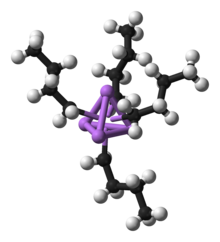Ortho-metallization
Under an ortho-metalation (or English directed ortho metalation and abbreviated DoM ) is the metalation of the appropriately substituted aromatic compounds with alkyllithium compounds. The substituents are referred to as direct metalation group (or DMG for short) and direct the metalation, through their intermediate deprotonation, into the ortho position of the aromatic. Examples of DMG are groups such as methyl ether , tertiary amines or the amide group.
mechanism
The aromatic with a DMG group interacts with the organolithium compound such as n - butyllithium and breaks the aggregation cluster (R-Li) n . This activates the organolithium compound in the immediate vicinity of the ortho hydrogen atom in such a way that it is abstracted from the carbanion and the corresponding carbon atom is thus metalated. Since the DMG is a Lewis base and lithium cations are Lewis acids , the metalated aromatic is stabilized.
In a further step, this metalated aromatic is then reacted with an electrophile and the product of a normal nucleophilic substitution or addition is obtained.
This type of reaction was published independently by Henry Gilman and Georg Wittig in 1939 and 1940, respectively.
Individual evidence
- ^ V. Snieckus: In Directed ortho metalation. Tertiary amide and O-carbamate directors in synthetic strategies for polysubstituted aromatics Chem. Rev. 1990 , 90 , 879-933.
- ↑ H. Gilman, RL Bebb: In Relative Reactivities of Organometallic Compounds. XX. * Metalation J. Am. Chem. Soc. 1939 , 61, 109-112.
- ↑ G. Wittig et al. Chem. Ber. 1940 , 73 , 1197.


